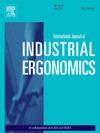基于视觉-触觉反馈系统的无人机人机感知一致性研究
IF 3
2区 工程技术
Q2 ENGINEERING, INDUSTRIAL
International Journal of Industrial Ergonomics
Pub Date : 2025-07-16
DOI:10.1016/j.ergon.2025.103780
引用次数: 0
摘要
人工智能(AI)已经成为一种有效的代理,可以在各种应用中以最少的人为干预来控制自主无人机的导航和目标搜索任务。尽管它们具有优势,但在将人类操作员的感知理解与自主无人机人工智能对环境变化的评估相结合方面存在重大挑战,特别是在动态和复杂的城市环境中。本研究通过提出一种人机感官共享系统来解决这一问题,该系统集成了视觉和触觉反馈,以增强态势感知,减少认知负荷,并提高对控制无人机的人工智能代理的信任。通过弥合人类和人工智能之间的感知差距,我们的方法促进了一种更具凝聚力和响应性的互动,使运营商能够实时做出明智的决策。通过模拟城市环境的人体实验(N = 30),参与者评估环境变化并根据多模态感官反馈调整无人机AI参数。收集眼球追踪数据,评估不同反馈条件下的认知负荷和投入。结果表明,视觉和触觉反馈的结合显著提高了用户的性能、满意度和决策速度,减少了人与人工智能之间的感知偏差。使用多模态反馈的参与者表现出比单模态反馈更快的响应时间和更高的环境评估准确性。本研究提出了直观的人-无人机交互系统设计,强调多模态感觉整合和生理监测在提高人机协作中的作用。这些发现对物流、搜索和救援、监视和环境监测等领域的应用具有重要意义,在这些领域,操作人员的参与和表现至关重要。本文章由计算机程序翻译,如有差异,请以英文原文为准。
Enhancing Human-AI perceptual alignment through visual-haptic feedback system for autonomous drones
Artificial Intelligence (AI) has emerged as an effective agent for controlling autonomous drones in navigation and target search tasks across various applications with minimal human intervention. Despite their advantages, significant challenges exist in aligning human operators' perceptual understanding with autonomous drone AI's assessment of environmental changes, particularly in dynamic and complex urban settings. This study addresses this issue by proposing a human-machine sensory sharing system that integrates visual and haptic feedback to enhance situational awareness, reduce cognitive load, and improve trust in the AI agent that controls the drones. By bridging the perceptual gap between humans and AI, our approach fosters a more cohesive and responsive interaction, enabling operators to make informed decisions in real-time. Through a human-subject experiment (N = 30) in a simulated urban environment, participants assessed environmental changes and adjusted drone AI parameters based on multimodal sensory feedback. Eye-tracking data were collected to evaluate cognitive load and engagement under different feedback conditions. Results show that combining visual and haptic feedback significantly enhances user performance, satisfaction, and decision-making speed, reducing perceptual misalignment between humans and AI. Participants using multimodal feedback demonstrated faster response times and higher environmental assessment accuracy than single-modality feedback. This research advances the design of intuitive human-drone interaction systems, emphasizing the role of multimodal sensory integration and physiological monitoring in improving human-machine collaboration. These findings have implications for applications in logistics, search and rescue, surveillance, and environmental monitoring, where operator engagement and performance are critical.
求助全文
通过发布文献求助,成功后即可免费获取论文全文。
去求助
来源期刊
CiteScore
6.40
自引率
12.90%
发文量
110
审稿时长
56 days
期刊介绍:
The journal publishes original contributions that add to our understanding of the role of humans in today systems and the interactions thereof with various system components. The journal typically covers the following areas: industrial and occupational ergonomics, design of systems, tools and equipment, human performance measurement and modeling, human productivity, humans in technologically complex systems, and safety. The focus of the articles includes basic theoretical advances, applications, case studies, new methodologies and procedures; and empirical studies.

 求助内容:
求助内容: 应助结果提醒方式:
应助结果提醒方式:


